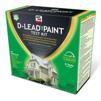
Lead Testing Decision Guide for pre-1979 Renovations
Testing in advance is less expensive and burdensome than clearance inspections
and it makes sense in situations where there is a low to medium probability of
finding LBP. For projects with a high probability of finding LBP, testing in advance
may just be an added cost that serves no purpose. The table and recommendations
below can help in making decisions to save time and cut costs.
and it makes sense in situations where there is a low to medium probability of
finding LBP. For projects with a high probability of finding LBP, testing in advance
may just be an added cost that serves no purpose. The table and recommendations
below can help in making decisions to save time and cut costs.
Probability of LBP (low, medium, and high)
|
This guide is for the purpose of completing renovation projects in pre-1979 construction with the least cost and
burden associated with lead-based paint (LBP) regulations. It's written primarily for projects inside the City of
San Diego but there may be occurrences when it's useful for projects elsewhere. In San Diego, unless tested in
advance to show otherwise, pre-1979 paint is assumed to be LBP and a lead clearance inspection is required at
the end of the project. This decision guide can help avoid paying for testing twice (pre-renovation testing and
clearance testing) on a project.
burden associated with lead-based paint (LBP) regulations. It's written primarily for projects inside the City of
San Diego but there may be occurrences when it's useful for projects elsewhere. In San Diego, unless tested in
advance to show otherwise, pre-1979 paint is assumed to be LBP and a lead clearance inspection is required at
the end of the project. This decision guide can help avoid paying for testing twice (pre-renovation testing and
clearance testing) on a project.
Lead Test Kits - What you Need to Know
False Negative - occurs when a test result gives a negative reading when in fact the
material sampled is positive for lead. False negatives pose a threat to human health by
giving a false impression that lead is not present and that lead-safe work practices are not
needed.
material sampled is positive for lead. False negatives pose a threat to human health by
giving a false impression that lead is not present and that lead-safe work practices are not
needed.
Recommendations
If all components impacted have a low or medium probability: Test with certified lead inspector in advance of
the work.
the work.
If any components impacted are high probability: Assume everything to be LBP, use lead-safe work practices,
and have a clearance inspection performed by a certified lead inspector upon completion of the work.
and have a clearance inspection performed by a certified lead inspector upon completion of the work.


It's the opinion of San Diego Testing that such levels of inaccuracy are unacceptable for anyone with budget
concerns. XRF lead testing is less expensive than clearance inspections and far less expensive than the
combination of clearance inspections and the usage of lead-safe work practices. If XRF lead testing is used
with consideration to the probability table and recommendations above then cost savings will be achieved.
concerns. XRF lead testing is less expensive than clearance inspections and far less expensive than the
combination of clearance inspections and the usage of lead-safe work practices. If XRF lead testing is used
with consideration to the probability table and recommendations above then cost savings will be achieved.
| Call or email for pricing or with any questions: 858-688-2868 jeff@sandiegotesting.com |
The EPA has "recognized" two test kits: D-Lead and 3M LeadCheck. Most states permit
the usage of these test kits to make a determination on whether lead-based paint is
present and whether RRP certification and lead-safe work practices are required. California
does not permit the usage of test kits to make such determinations due to their high level
of inaccurate results. However, test kits are available in California and are often promoted
as a lead screening tool.
the usage of these test kits to make a determination on whether lead-based paint is
present and whether RRP certification and lead-safe work practices are required. California
does not permit the usage of test kits to make such determinations due to their high level
of inaccurate results. However, test kits are available in California and are often promoted
as a lead screening tool.
San Diego Testing recommends against using lead test kits as a screening tool because
the inaccuracies ultimately will waste time and money to the contractor and property owner
(as will be explained in detail below). We have found that the most cost effective method
to handle lead paint requirements is to use the probability table and recommendations
previously suggested on this page. To explain the reasoning for this conclusion it's
necessary to discuss two terms that are used to describe the accuracy of a test method.
the inaccuracies ultimately will waste time and money to the contractor and property owner
(as will be explained in detail below). We have found that the most cost effective method
to handle lead paint requirements is to use the probability table and recommendations
previously suggested on this page. To explain the reasoning for this conclusion it's
necessary to discuss two terms that are used to describe the accuracy of a test method.
False Positive - occurs when a test result gives a positive reading when in fact the material sampled is negative
for lead. False positives pose no threat to human health but they do cause unnecessary expenses associated
with lead-safe work practices and clearance inspection requirements.
for lead. False positives pose no threat to human health but they do cause unnecessary expenses associated
with lead-safe work practices and clearance inspection requirements.
The original text of the EPA RRP Rule stated that recognized test kits must have no more than 5% false
negatives and no more than 10% false positives. Once it was apparent that these levels of accuracy were
impossible to achieve using a home test kit, EPA reconsidered and decided to focus only on false negatives.
That's because a false positive is not going to put human health in jeopardy and a false negative could. False
positives cause contractors and property owners unnecessary expenses, but reducing such expenses is not an
objective of the EPA. To get a sense of how much wasted costs these test kits cause, it's important to know
the percentage of false positives each generate.
negatives and no more than 10% false positives. Once it was apparent that these levels of accuracy were
impossible to achieve using a home test kit, EPA reconsidered and decided to focus only on false negatives.
That's because a false positive is not going to put human health in jeopardy and a false negative could. False
positives cause contractors and property owners unnecessary expenses, but reducing such expenses is not an
objective of the EPA. To get a sense of how much wasted costs these test kits cause, it's important to know
the percentage of false positives each generate.
D-Lead false positives: 29% in a non-laboratory environment. (full results)
3M LeadCheck false positives: 98% in a non-laboratory environment. (full results)

| Lead - Asbestos - Mold Experts in San Diego |
